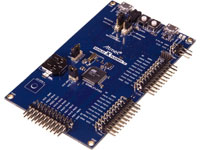For those unfamiliar with the MCU industry, it should be noted that companies within this niche line of manufacturing are constantly competing with one another to offer the lowest power consumption possible.
The list of achievements recorded in recent years is impressive, but none more so than the latest ultra-low power MCU to be introduced, the SAM L21, which comes from Atmel.

An ARM Cortex-M0+ based family of MCUs, this line of processor features power consumption down to 35µA/MHz in active mode and 200nA in sleep mode. Per the EEMBC ULPBench, which is considered the industry’s standard for benchmarking an MCUs power consumption, Atmel’s SAM L21 scored a 185 (the higher the better) which, according to the company, is the highest-publicly-recorded score for any Cortex-M-based processor or MCU in the world.

Also worth noting is that Atmel’s line of SAM L21 produces consumes less than 940nA with full 40KB SRAM retention, real-time clock and calendar, and 200nA in the deepest sleep mode. The company is able to achieve these impressive recordings by way of multiple power domains, similar to the way in which its clocking system is implemented, the way by which its regulators are implemented, and the use of smart peripherals. Put it all together and this technology can make simple decisions without having to wake the main processor core.
Atmel’s SAM L21 goes beyond gating clocks — it also gates power, completely disconnecting the power rails from functions that are not in use. And because of the technology’s aforementioned smart peripheral system, even when they are powered down, a tiny part of each peripheral keeps an eye on what’s happening in the outside world. Should it notice something, it will request clock and data services; in fact, it will even take action to wake the main CPU should a situation justify such an action.
The L21’s PD0 power domain includes simple, low-power communication functions, timers, peripheral touch controller, and more. The MCU’s custom configurable logic block features four 3-input lookup tables that can implement a mix of combinatorial logic functions (AND, NAND, OR, NOR, XOR, XNOR, NOT) and sequential logic functions (gates D-type flip-flop, JK-type flip-flop, gated D-type latch, RS latch). This allows the user to connect to the event system (including peripherals), interrupt system, and general-purpose input / outputs. Furthermore, should the user be so inclined, he / she can even cascade them all together, so as to create fully customizable, deeply sophisticated “wake-up” conditions for all different functional blocks.
Atmel has also recently announced the release of its SAM L21 Xplained Pro Evaluation kit, a hardware platform specially designed to evaluate the ATSAML21J18A microcontroller. It comes with several great features, including:
• ATSAML21J18A microcontroller
• One mechanical reset button
• One mechanical user pushbutton
• One yellow user LED
• Backup battery
• 32.768 kHz crystal
• USB interface, device and host mode
• Three Xplained Pro extension headers
• One QTouch® button
• Supported with application examples in Atmel Software Framework
• USB powered
• Embedded debugger
– Auto-ID for board identification in Atmel Studio
– One yellow status LED
– One green board power LED
– Symbolic debug of complex data types including scope information
– Programming and debugging, including power measurement
– Data Gateway Interface: SPI, I2C, 4 GPIOs
– Virtual COM port (CDC)
By using Xplained Pro and Atmel Studio, a developer has the ability to monitor in real-time the amount of power consumption taking place. Should a power spike appear, the developer can then look back to see what caused it in the code, and make adjustments as necessary.
Request a SAM L21 Xplained Pro Evaluation Kit
Learn more about Atmel’s approach to reducing power consumption while maintaining performance
For a more in-depth look at Atmel’s approach to system designs, download Turn Power-Reducing Features into Low-Power Systems
Advertisement
Learn more about Atmel





